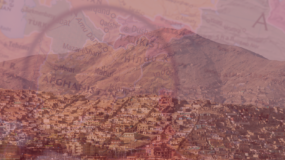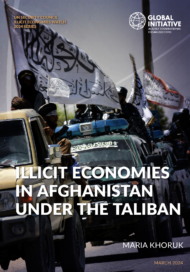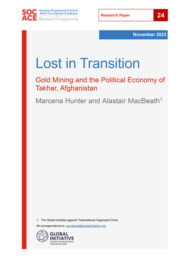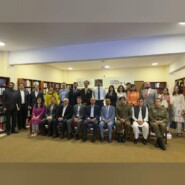Posted on 06 Feb 2025
When the Taliban seized power in Kabul in 2021, they wrested control of a vast arsenal of weapons from the outgoing regime. Over 40 years of cumulative wars had flooded the country with arms and ammunition.
The arsenal was swelled by copy weapons produced by Pakistani artisans, arms supplied to the Taliban by neighbouring states during the insurgency, and weapons and ammunition donated to the previous regime by NATO and the US. The Taliban also procured military equipment directly from commercial supply chains. The exact number of firearms is unclear, but the scale of the delivery of advanced NATO and US weapons to Afghanistan since 2001 is staggering, representing one of the greatest risks of large-scale diversion of weapons and ammunition into illicit markets in recent history. Global organized crime groups have already capitalized, trading Colombian cocaine for Afghan firearms in 2023. The Taliban’s commitment to controlling this risk is questionable.
Afghanistan is a party to the international treaties and protocols that stipulate states’ obligations to control the diversion of weapons to illicit markets, including the 2013 Arms Trade Treaty, the 2001 UN Programme of Action on small arms and light weapons, and the 2001 Firearms Protocol to the UN Convention against Transnational Organized Crime. State transparency in addressing the risks of diversion to illicit markets is a key factor in meeting these obligations, as is commitment to sharing data, information and best practices. However, the Taliban are anything but transparent when it comes to the control mechanisms that are central to weapons governance. The regime’s clandestine, profit-making activities and potential collusion with criminal actors are a serious obstacle to achieving greater levels of transparency.
Senior Taliban officials, speaking on condition of anonymity, acknowledged that its commanders retained weapons for their private security or onward sale when they took over. As a result, weapons and ammunition fell into the hands of smugglers and militants. Shortly after the takeover of Kabul, Talibs brandished NATO-issued weapons and used them in campaigns against the National Resistance Forces in Panjshir and Takhar provinces. In 2022, Pakistani officials expressed concern that the Islamist militant alliance Tehrik-e-Taliban Pakistan (TTP) were using modern weapons diverted from NATO stockpiles, as these weapons gave TTP militants an advantage over Pakistani police and military personnel along the Afghanistan–Pakistan border region, leading to disproportionate casualties among their personnel. In addition, separatist insurgents in Balochistan and Baloch Islamists in Iran have been seen carrying NATO weaponry, allegedly from Afghanistan, while Tajikistan and Iran claimed to senior UN officials in 2022 that weapons were being smuggled across their borders from Afghanistan.
Despite this evidence of weapons flowing from Afghanistan, in early 2023 Taliban officials declared in private conversation with international observers that weapons and ammunition smuggling had been eliminated, and that they had addressed the issue of uncontrolled weapons flows. They pointed to their system of licensing and registration documents needed for individuals to own weapons, and spoke of how they were removing weapons caches from individual commanders. This narrative was repeated at all levels – from district governors in rural areas to security ministers in Kabul.
However, research published in July 2023 confirmed the presence of arms markets in key border areas and raised renewed concerns about smuggling to the TTP. Apparently, the Taliban had not eliminated the long-standing cross-border links between armed groups and smuggling networks. Although the General Directorate of Intelligence (GDI), the Taliban’s intelligence agency, had seized hundreds of weapons, Taliban-allied groups continued to gain access to US weapons. At the same time, the Taliban had been slow to adopt new policies on the management of arms markets due to internal power dynamics.
Pressured by the international community, the Taliban’s strategy seems to have started to change. In early 2024, Hibatullah Akhundzada, the Taliban’s supreme leader and Afghanistan’s emir, issued a decree instructing a registration and monitoring commission to oversee weapons registration in 29 provinces. The commission’s head, working on the emir’s authority and with his decree as guidance, ordered senior Taliban officials to fully cooperate to ensure all ‘pre-conquest and post-conquest’ weapons were properly registered and handed over. Senior Taliban officials reported in private conversations that the commission’s head effectively instigated the Disarmament of Illegal Armed Groups programme, which included registration, licencing, amnesties, buy-back programmes, ballistic testing for evidential purposes, stockpile management and seizures from smugglers, illegal armed groups and rogue commanders. It targeted members of the security forces, private citizens, businessmen and their security details, and local commanders.
However, this measure appears to have been ineffective. Further research published in May 2024 found that arms markets continued to operate and that former power brokers were able to retain their hidden stockpiles. That same year, reports by the UN Sanctions Monitoring Team indicated that Central Asian countries were still interdicting weapons from Afghanistan, and a few months earlier, in December 2023, Pakistan had expressed concern about the Taliban’s unwillingness or inability to act in an appeal to the UN Security Council regarding the TTP.
In November 2024, Hibatullah responded by issuing a decree consolidating authority over arms, ammunition and military equipment under his direct control. This ruling stripped the ministries of defence and interior, and the GDI, of their autonomy over weapons control and management – and any profits from their diversion into illicit markets. According to the emir’s spokesperson, the move was intended to prevent the misuse of public funds and ensure the proper preservation of Afghanistan’s arsenal.
This move shows the emir’s concerns about security and his ability to maintain control over the country’s stockpiles, a key source of power. At a time of internal tension within the Taliban, it is a political manoeuvre aimed at consolidating authority – the centralization of arms control diminishes the ministries’ influence and reinforces the emir’s dominance. This tactic reflects Hibatullah’s wider trend of using commissions, such as the registration and monitoring initiative, to maintain a tight grip on power and prevent commanders from amassing unchecked wealth and stocks of firearms. Indeed, the assassination in December 2024 of Khalil Haqqani, an influential voice among the more moderate sources of Taliban power in the country, implies Kandahar will use any means to weaken unsupportive factions.
Afghanistan’s porous borders, thriving black market at the crossroads of Asia and autocratic state control have long made it a hub for illicit arms dealers. The Taliban’s centralization of weapons control through the new decree may appear to counter these trends, but it is a patina lacking robust enforcement mechanisms, let alone buy-in from all power groups in the country. Although the emir’s centralization efforts may curb some misuse and smuggling in the short term, underlying political tensions and lack of transparency threaten to derail any real progress to diminish the flows of firearms. Resistance from commanders who will be forced to hand over stockpiles of weapons is to be expected. For Afghanistan to move towards lasting peace, the Taliban must address the root causes of its weapons crisis: trust deficits, institutional weaknesses and the pervasive influence of illicit networks. Only then can the nation break free from the cycle of power struggles and achieve stability.



